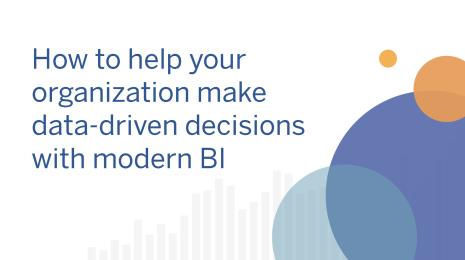How UMHS saved millions and won an award with self-service analytics
Imagine saving more than 10,000 hours a year, turning 4.5 hours of wait-time to 4.5 seconds, clearing 80% of someone’s road blocks in just an hour, and saving more than $ 3 million in the process!
That’s what happened when the University of Michigan Health System (UMHS) adopted a self-service approach to analytics. The organization’s Fast Analytics team recently won the Project of the Year award in Health Data Management’s Analytics All-Stars Awards.
The five-person team has had huge impact across the health system of three hospitals, 40 outpatient hospitals, and more than 140 clinics. The team “reduced 10,000 hours in redundant labor and recovered more than $3 million in Recovery Audit Contractor (RAC) money in the 2015 fiscal year through operational efficiency improvements,” according to Health Data Management.
Empowering people to explore the data
It used to be that the analytics team at UMHS managed its large and archaic billing system. To produce reports, the team either had to do the coding in-house or pay large fees to an outside vendor—and the final output was often late or incorrect.
“We had to fight our way through all kinds of vendor interactions in order to have the right to pay huge sums of money for report alterations, and it wasn’t a cost-effective way of reporting,” says Jonathan Greenberg, director of the UMHS Fast Analytics team.
Even when the reports were correct and on time, they were static; people couldn’t easily dive deeper and ask follow-up questions.
People wanted a better way. And after reviewing more than a dozen solutions, UMHS chose Tableau to help everyone, not just the experts, see and understand their data. UMHS also formed the Fast Analytics team to assist more than 30 groups with their dashboards.
With Tableau and a dedicated analytics team, UMHS changed the way people interact with data. In place of static reports, people could look to automated, interactive dashboards for up-to-the-second, actionable insights. They could also ask their own questions of the data.
“It’s about giving people a simple and intuitive way to drill down into the data,” says Jonathan.
Hours and hours of work now reduced to seconds
Since UMHS adopted these dashboards, the organization has seen huge time savings, says Jonathan.
“We found that Tableau allows us to quickly automate processes that used to take thousands—literally thousands—of hours into seconds,” says Jonathan.
In one case, a dashboard managed to trim 48 hours of busy work every week, freeing the team member to take on a more strategic role.
Jonathan’s team also helps other UMHS departments build their own dashboards through the one-hour challenge. The department would provide the data, and the team would spend an hour creating a dashboard that highlights insights and opportunities for improvement.
“We'd shoot for an 80/20 on one of their problems. And we'd go back and we'd hand it to them. And they would say things like, ‘This solves 80 percent of my problems,’” says Jonathan.
And with self-service dashboards, more people can ask their own questions of the data instead of relying on someone else.
“If we build the dashboards right, the menu structures and everything else are intuitive, and people know how to use the tool without much training. That is so incredible,” says Jonathan.
How patients benefit from this approach
Speed and time are critical factors in the high-pressure world of medicine. The data might contain potentially life-saving insights—which treatments have succeeded or failed under specific circumstances, for example—but if the analysis takes too long, doctors can’t afford to wait.
“Doctors out there don’t have time; if they wait more than seven seconds for a page to open, they’re gone,” he says.
Patients are benefitting from speed-of-thought analysis in other areas as well. It used to be that when patients asked about the cost of a specific procedure, UMHS would have to rely on multiple tools and a great deal of expertise to find the answer. This process typically took 4.5 hours to complete.
With Tableau, that wait time is now down to 4.5 seconds—a huge win in both efficiency and customer service.
It’s clear: The small but mighty—and award-winning!—team at UMHS is producing big results.
Watch Jonathan discuss his team's approach to self-service analytics:Autres sujets pertinents
Abonnez-vous à notre blog
Recevez toute l'actualité de Tableau.








